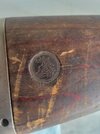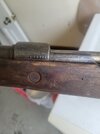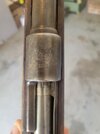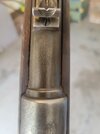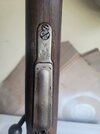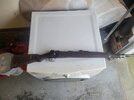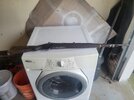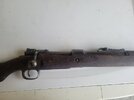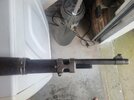You are using an out of date browser. It may not display this or other websites correctly.
You should upgrade or use an alternative browser.
You should upgrade or use an alternative browser.
Mauser banner Standard model
- Thread starter Pelo801
- Start date
NIGHTLORD40K
Member
Commercial K98 likely pressed into military service during WW2, as supported by the Waffenampts on the replacement bottom metal.
Neato! Do you plan on restoring it?
Neato! Do you plan on restoring it?
Dave DeLaurant
Member
The Lion of Judah on the barrel is an Ethiopian thang, as is St. George badge on the buttstock and the rough overall condition. There is an interesting mix of early and late parts -- the stock is a late pattern, with the cupped buttplate w/firing pin disassembly hole. The stock looks laminated, and plus there's that weird reddish-purple tinge I usually associate with Russian rebuilds. The rear barrel band is the late stamped/welded type with the screw hole, while the front is a machined H-type G98 style with the sling hook, both held in place with a flat spring. Ian gives a rough chronology of the K98k's wartime simplifications in this video:

 www.youtube.com
www.youtube.com
Wild guessing here: I'd propose the barreled action was a Soviet-confiscated pre-war Mauser Standard Modell (possibly captured from a teenaged or septuagenarian member of the Volkssturm) that was reworked postwar with whatever parts happened to be on the bench at the time, then sent to Ethiopia via Czechoslovakia with a big batch of K98ks purchased from them by the Ethiopians, marked with the stock disc and barrel stamp, then dragged by its sling (possibly rope) through the sand and rocks of Eritrea for 30 years before being replaced by Kalashnikovs sometime in the 1970s or '80s after Selassie was deposed by commies, and then finally put into storage until bought up by InterOrdnance/Royal Tiger. Cool!

Evolution of the Karabiner 98k, From Prewar to Kriegsmodell
https://www.forgottenweapons.com/evolution-of-the-karabiner-98k-from-prewar-to-kriegsmodellhttp://www.patreon.com/ForgottenWeaponsCool Forgotten Weapons merc...
Wild guessing here: I'd propose the barreled action was a Soviet-confiscated pre-war Mauser Standard Modell (possibly captured from a teenaged or septuagenarian member of the Volkssturm) that was reworked postwar with whatever parts happened to be on the bench at the time, then sent to Ethiopia via Czechoslovakia with a big batch of K98ks purchased from them by the Ethiopians, marked with the stock disc and barrel stamp, then dragged by its sling (possibly rope) through the sand and rocks of Eritrea for 30 years before being replaced by Kalashnikovs sometime in the 1970s or '80s after Selassie was deposed by commies, and then finally put into storage until bought up by InterOrdnance/Royal Tiger. Cool!
Last edited:
NIGHTLORD40K
Member
As good a story as we will ever know. Love it!!!The Lion of Judah on the barrel is an Ethiopian thang, as is St. George badge on the buttstock and the rough overall condition. There is an interesting mix of early and late parts -- the stock is a late pattern, with the cupped buttplate w/firing pin disassembly hole. The stock looks laminated, and plus there's that weird reddish-purple tinge I usually associate with Russian rebuilds. The rear barrel band is the late stamped/welded type with the screw hole, while the front is a machined H-type G98 style with the sling hook, both held in place with a flat spring. Ian gives a rough chronology of the K98k's wartime simplifications in this video:

Evolution of the Karabiner 98k, From Prewar to Kriegsmodell
https://www.forgottenweapons.com/evolution-of-the-karabiner-98k-from-prewar-to-kriegsmodellhttp://www.patreon.com/ForgottenWeaponsCool Forgotten Weapons merc...www.youtube.com
Wild guessing here: I'd propose the barreled action was a Soviet-confiscated pre-war Mauser Standard Modell (possibly captured from a teenaged or septuagenarian member of the Volkssturm) that was reworked postwar with whatever parts happened to be on the bench at the time, then sent to Ethiopia via Czechoslovakia with a big batch of K98ks purchased from them by the Ethiopians, marked with the stock disc and barrel stamp, then dragged by its sling (possibly rope) through the sand and rocks of Eritrea for 30 years before being replaced by Kalashnikovs sometime in the 1970s or '80s after Selassie was deposed by commies, and then finally put into storage until bought up by InterOrdnance/Royal Tiger. Cool!
Pelo801
Member
- Joined
- Mar 30, 2014
- Messages
- 399
Great info. I love the speculative story too. The stock does have a weird reddish tinge. But it's not laminate. It's just been abused someThe Lion of Judah on the barrel is an Ethiopian thang, as is St. George badge on the buttstock and the rough overall condition. There is an interesting mix of early and late parts -- the stock is a late pattern, with the cupped buttplate w/firing pin disassembly hole. The stock looks laminated, and plus there's that weird reddish-purple tinge I usually associate with Russian rebuilds. The rear barrel band is the late stamped/welded type with the screw hole, while the front is a machined H-type G98 style with the sling hook, both held in place with a flat spring. Ian gives a rough chronology of the K98k's wartime simplifications in this video:

Evolution of the Karabiner 98k, From Prewar to Kriegsmodell
https://www.forgottenweapons.com/evolution-of-the-karabiner-98k-from-prewar-to-kriegsmodellhttp://www.patreon.com/ForgottenWeaponsCool Forgotten Weapons merc...www.youtube.com
Wild guessing here: I'd propose the barreled action was a Soviet-confiscated pre-war Mauser Standard Modell (possibly captured from a teenaged or septuagenarian member of the Volkssturm) that was reworked postwar with whatever parts happened to be on the bench at the time, then sent to Ethiopia via Czechoslovakia with a big batch of K98ks purchased from them by the Ethiopians, marked with the stock disc and barrel stamp, then dragged by its sling (possibly rope) through the sand and rocks of Eritrea for 30 years before being replaced by Kalashnikovs sometime in the 1970s or '80s after Selassie was deposed by commies, and then finally put into storage until bought up by InterOrdnance/Royal Tiger. Cool!
NIGHTLORD40K
Member
Does it have any import markings? Perhaps under the front of the barrel.
Mosin77
Member
- Joined
- Oct 7, 2019
- Messages
- 1,589
One doesn’t like to generalize too much but these Ethiopian rifles were pretty darn rare until RTI brought in boatloads of them in the last few years. So while I’d be shocked if it didn’t have an import mark…..if it didn’t it’s probably worth considerably more.Does it have any import markings? Perhaps under the front of the barrel.
Carl N. Brown
Member
Wild guess (based on other guns' actual histories) that would make a semi-documentary.....
Wild guessing here: I'd propose the barreled action was a Soviet-confiscated pre-war Mauser Standard Modell (possibly captured from a teenaged or septuagenarian member of the Volkssturm) that was reworked postwar with whatever parts happened to be on the bench at the time, then sent to Ethiopia via Czechoslovakia with a big batch of K98ks purchased from them by the Ethiopians, marked with the stock disc and barrel stamp, then dragged by its sling (possibly rope) through the sand and rocks of Eritrea for 30 years before being replaced by Kalashnikovs sometime in the 1970s or '80s after Selassie was deposed by commies, and then finally put into storage until bought up by InterOrdnance/Royal Tiger. Cool!
Use that story as flash backs in a present day parallel story of a backcountry Alaskan or Canadian farmer usng that rifle to defend family, livestock, homestead from a rogue grizzly, you got an outdoorsy movie of the week.
dh1633pm
Contributing Member
I like Dave's story the best.
jobu07
Contributing Member
It looks like a laminate stock to me. In addition to the layers of glued wood visible in pictures one and two there are layers clearly seen on the above and below rifle views in pictures three, four, and five.Great info. I love the speculative story too. The stock does have a weird reddish tinge. But it's not laminate. It's just been abused some
Dave DeLaurant
Member
It looks like a laminate stock to me. In addition to the layers of glued wood visible in pictures one and two there are layers clearly seen on the above and below rifle views in pictures three, four, and five.
The best way to confirm this is to remove the triggerguard assembly or the buttplate to see whether the even wood layers are more conspicuous edge-on.
The cupped buttplate was more common with laminate stocks, but not universally so. If it really was a Russian refurb, I wouldn't be surprised either way -- their goal was functionality and they used whatever wood was handy. The Germans were thinking the same way by the end of 1944.
Last edited:


